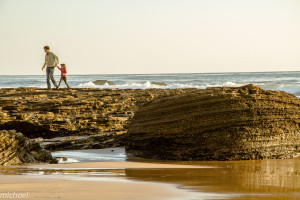Community Voices – A Refuge and a Reminder: Why Protect the Habitat at Crystal Cove
Editor’s note: Welcome to the Wave’s first Community Voices guest post! Crystal Cove Alliance has always had a wonderful group of passionate supporters and advocates. Beginning this month, the Wave will periodically feature stories by guest writers, artists, naturalists, historians and other fascinating individuals from the local community. This community voice comes from Virginia Webber.
Like a curtain drawn back for a preview of a show, low tide at Crystal Cove offers a glimpse into a vibrant ocean world. This brief visibility of sea creatures and plants is what makes tidepools so special and inviting; they’re windows into the workings of underwater life that’s usually hidden from us. Until the tide returns, we’re able to magically explore the ocean while standing on dry land.
Not far from the tidepools, at the outdoor Berns Amphitheater, an audience plays a game called Tidepool Jeopardy to show what they’ve learned in a ranger chat. Why is a starfish more properly called a sea star? Hands wave. Everyone knows the answer. “Because a starfish isn’t a fish!” Why should we not pick up shells? “Because a hermit crab might need it for its house!” Arriving at these seemingly simple answers requires thinking about the properties that make a fish a fish, and about what conditions a fish, a sea star, or a hermit crab needs to live.

Tidepool Jeopardy is about conditions necessary for life, and this audience of Crystal Cove campers and visitors is ready to use their knowledge to answer even the most challenging “3-Sand-Dollar” questions about amazing adaptations, interactive ecosystems, and what we can do to be wise stewards. Tidepool Jeopardy offers a clue to one good reason among the many good reasons to conserve the habitat of Crystal Cove, which is that witnessing how the natural world works inspires wonder, and wonder inspires inquiry and understanding. This perspective is one of the most promising paths to solutions for the future.
Practical reasons for conserving habitat sustain the aesthetic and cultural ones for a place as beautiful and beloved as Crystal Cove, and reinforce the interconnectedness of life and well-being in a setting that draws visitors from the community and around the world.
Dr. Sylvia Earle, former chief scientist at NOAA and champion of Marine Protected Areas like the one at Crystal Cove offers the most practical habitat conservation argument of all, which is the singular role of the ocean in supporting life:
“With every drop of water you drink, every breath you take, you’re connected to the sea. No matter where on Earth you live.”
Habitat protection at Crystal Cove acknowledges that the life revealed at our tidepools is just the beginning of a living world ocean that governs all life on our planet, including the conditions necessary for sea stars, hermit crabs, and for air-breathing humans to thrive.
The nature of the shoreline makes it feel like a place where the ocean and the land part ways, but they never actually do. As Dr. Earle points out, no matter how far inland we travel or live, we remain connected to the one world ocean that covers more than 70% of the Earth’s surface. The world revealed by low tide is not really a different world at all, but part of the same world we inhabit on land. Land and sea are both part of a profoundly interconnected Earth system. When we protect life in our ocean, we protect life on our land as well.
shoreline makes it feel like a place where the ocean and the land part ways, but they never actually do. As Dr. Earle points out, no matter how far inland we travel or live, we remain connected to the one world ocean that covers more than 70% of the Earth’s surface. The world revealed by low tide is not really a different world at all, but part of the same world we inhabit on land. Land and sea are both part of a profoundly interconnected Earth system. When we protect life in our ocean, we protect life on our land as well.
Crystal Cove is a unique model for balancing access with conservation because of the diversity of its reach in encouraging people to enjoy, understand, and respect the natural world and protected habitat. A middle school student monitoring water quality may be inspired to further study. A child who understands that carelessly moving a rock in a tidepool affects another creature is learning to think like a steward. A plein air artist documents a living landscape in real time. A guest in a restored ocean-front cottage or a day visitor on a beach towel experiences the most available visible evidence of the forces of the natural world in the simple joy of watching the tide.
Protected habitat creates a sanctuary that safeguards beauty as well as “source knowledge,” which is recognition of where the conditions necessary for life come from. Just as the returning tide obscures the workings of life in the intertidal zone, our modern lifestyle can obscure the real workings of life in the rest of our world. Through its surpassing beauty, iconic heritage, and protected habitat, Crystal Cove remains both refuge and reminder that we are part of a wondrous and dynamic interconnected planet.
Photos courtesy of Michael Dresser
***
Except for a few years living on the slopes of a volcano in a rural Hawaiian town without a single stoplight, Virginia has lived in Orange County since 1988.
***
Crystal Cove Alliance would love to hear what you thought about this month’s community voice. Write in responses or feedback in the comments section below.

